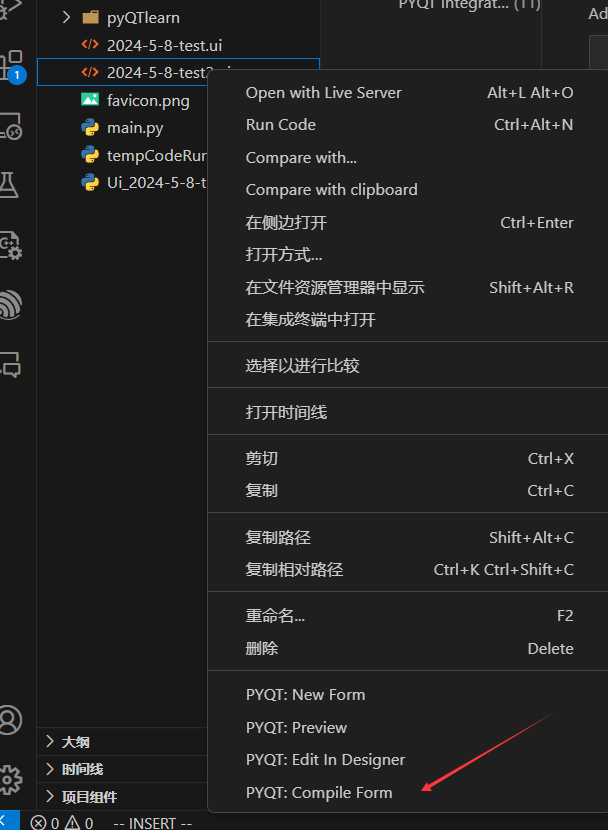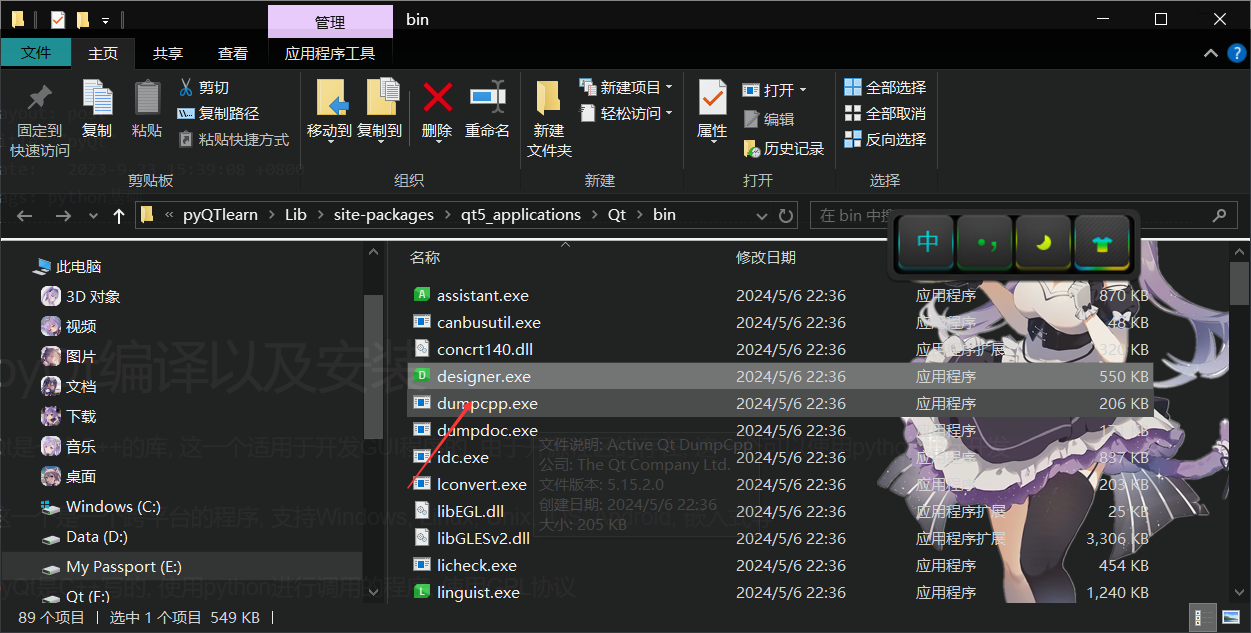Appearance
pyQt编译以及安装
Qt是一个C++的库, 这一个适用于开发GUI程序的, 由于开源社区的存在, 这一个可以使用python进行开发
这一个是一个跨平台的程序, 支持Windows, Linux, Unix, IOS, Android, 嵌入式等
pyQt是C++写的, 使用python进行调用的程序, 使用GPL协议
还有一个PySide2也是一个使用python进行图形化开发的库, 但是使用的数量不如pyQt
bash
pip install PyQt5 -i https://pypi.tuna.tsinghua.edu.cn/simple
pip install PyQt5-tools -i https://pypi.tuna.tsinghua.edu.cn/simple安装PyQt5-tools之后可以使用
这一个进行图形化开发
python
from PyQt5 import QtWidgets
from PyQt5.QtCore import *
print(QT_VERSION_STR)测试
python
import sys
from PyQt5.QtWidgets import QWidget, QApplication
# 创建一个app对象, 参数是这一个程序运行的变量
app = QApplication(sys.argv)
widget = QWidget()
widget.resize(640, 480)
widget.setWindowTitle("Hello, PyQt5!")
widget.show()
# 执行这一个app
sys.exit(app.exec())基础模块
- QtCore: 核心的非GUI的功能, 主要是时间, 文件文件夹, 各种数据, 流, URLs, mine类文件, 进程和线程使用
- QtGui: 窗口系统, 事件处理, 2D图像, 基本绘图, 字体文字类
- QtWidget: 插件, 应用UI元素
python
import sys
from PyQt5.QtWidgets import *
from PyQt5.QtCore import *
class Window1(QWidget):
def __init__(self):
super().__init__()
QLabel("抽屉1", self)
self.setStyleSheet("background-color:red;")
class Window2(QWidget):
def __init__(self):
super().__init__()
QLabel("抽屉2", self)
self.setStyleSheet("background-color:green;")
class MyWindow(QWidget):
def __init__(self):
super().__init__()
self.create_stacked_layout()
self.init_ui()
def create_stacked_layout(self):
self.stacked_layout = QStackedLayout()
win1 = Window1()
win2 = Window2()
self.stacked_layout.addWidget(win1)
self.stacked_layout.addWidget(win2)
def init_ui(self):
self.setFixedSize(300, 270)
container = QVBoxLayout()
widget = QWidget()
# 添加一个抽屉布局器
widget.setLayout(self.stacked_layout)
widget.setStyleSheet("background-color:grey;") # 这一个样式是CSS的样式
# 两个按钮
btn_press1 = QPushButton("1")
btn_press2 = QPushButton("2")
# 设置按键的功能
btn_press1.clicked.connect(self.btn_press1_clicked)
btn_press2.clicked.connect(self.btn_press2_clicked)
# 显示空间添加组件
container.addWidget(widget)
container.addWidget(btn_press1)
container.addWidget(btn_press2)
self.setLayout(container)
def btn_press1_clicked(self):
self.stacked_layout.setCurrentIndex(0)
def btn_press2_clicked(self):
self.stacked_layout.setCurrentIndex(1)
if __name__ == '__main__':
app = QApplication(sys.argv)
w = MyWindow()
w.show()
app.exec()Vscode设置
在Visual Studio Code中使用PyQt5开发python GUI应用程序 - 知乎 (zhihu.com)
ui文件转py

python
# -*- coding: utf-8 -*-
# Form implementation generated from reading ui file 'e:\JHY\python\2024-5-6-pyQt\2024-5-8-test2.ui'
#
# Created by: PyQt5 UI code generator 5.15.10
#
# WARNING: Any manual changes made to this file will be lost when pyuic5 is
# run again. Do not edit this file unless you know what you are doing.
import sys
from PyQt5 import QtCore, QtGui, QtWidgets
from PyQt5.QtWidgets import *
class Ui_Form(object):
def setupUi(self, Form):
Form.setObjectName("Form")
Form.resize(596, 198)
self.formLayoutWidget = QtWidgets.QWidget(Form)
self.formLayoutWidget.setGeometry(QtCore.QRect(40, 30, 251, 61))
self.formLayoutWidget.setObjectName("formLayoutWidget")
self.formLayout = QtWidgets.QFormLayout(self.formLayoutWidget)
self.formLayout.setContentsMargins(0, 0, 0, 0)
self.formLayout.setObjectName("formLayout")
self.label = QtWidgets.QLabel(self.formLayoutWidget)
self.label.setObjectName("label")
self.formLayout.setWidget(0, QtWidgets.QFormLayout.LabelRole, self.label)
self.label_2 = QtWidgets.QLabel(self.formLayoutWidget)
self.label_2.setObjectName("label_2")
self.formLayout.setWidget(1, QtWidgets.QFormLayout.LabelRole, self.label_2)
self.lineEdit = QtWidgets.QLineEdit(self.formLayoutWidget)
self.lineEdit.setObjectName("lineEdit")
self.formLayout.setWidget(0, QtWidgets.QFormLayout.FieldRole, self.lineEdit)
self.lineEdit_2 = QtWidgets.QLineEdit(self.formLayoutWidget)
self.lineEdit_2.setObjectName("lineEdit_2")
self.formLayout.setWidget(1, QtWidgets.QFormLayout.FieldRole, self.lineEdit_2)
self.textBrowser = QtWidgets.QTextBrowser(Form)
self.textBrowser.setGeometry(QtCore.QRect(320, 20, 256, 151))
self.textBrowser.setObjectName("textBrowser")
self.horizontalLayoutWidget = QtWidgets.QWidget(Form)
self.horizontalLayoutWidget.setGeometry(QtCore.QRect(90, 110, 201, 41))
self.horizontalLayoutWidget.setObjectName("horizontalLayoutWidget")
self.horizontalLayout = QtWidgets.QHBoxLayout(self.horizontalLayoutWidget)
self.horizontalLayout.setContentsMargins(0, 0, 0, 0)
self.horizontalLayout.setObjectName("horizontalLayout")
self.pushButton_2 = QtWidgets.QPushButton(self.horizontalLayoutWidget)
self.pushButton_2.setObjectName("pushButton_2")
self.horizontalLayout.addWidget(self.pushButton_2)
self.pushButton = QtWidgets.QPushButton(self.horizontalLayoutWidget)
self.pushButton.setObjectName("pushButton")
self.horizontalLayout.addWidget(self.pushButton)
self.retranslateUi(Form)
self.pushButton_2.clicked.connect(self.textBrowser.hide) # type: ignore
QtCore.QMetaObject.connectSlotsByName(Form)
def retranslateUi(self, Form):
_translate = QtCore.QCoreApplication.translate
Form.setWindowTitle(_translate("Form", "Form"))
self.label.setText(_translate("Form", "用户名"))
self.label_2.setText(_translate("Form", "密码"))
self.pushButton_2.setText(_translate("Form", "登录"))
self.pushButton.setText(_translate("Form", "忘记密码"))
if __name__ == '__main__':
app = QApplication(sys.argv)
MainWindow = QWidget()
ui = Ui_Form() # ui=GUI的py文件名.类名
ui.setupUi(MainWindow) # 设置一个显示的窗口
MainWindow.show()
sys.exit(app.exec_())python
from PyQt5 import uic
import UItest2 as UI
class MyWindow(UI.Ui_Form, QMainWindow):
def __init__(self):
super().__init__()
self.setupUi(self)
self.retranslateUi(self)
if __name__ == '__main__':
app = QApplication(sys.argv)
w = MyWindow()
w.show()
app.exec()